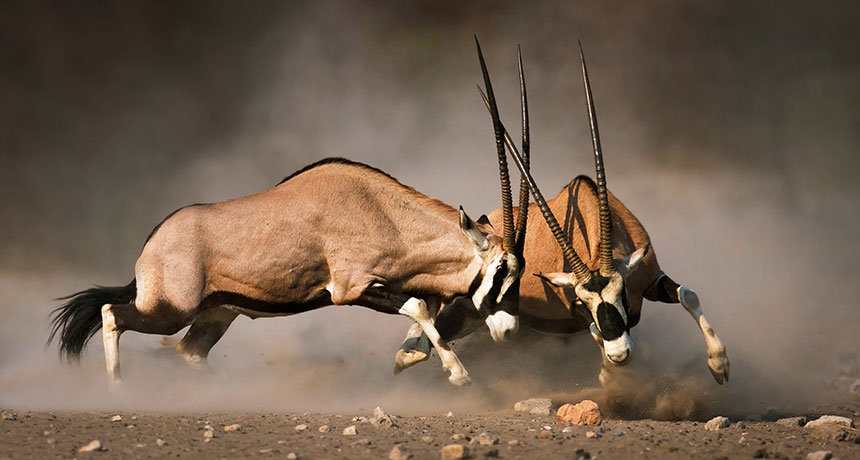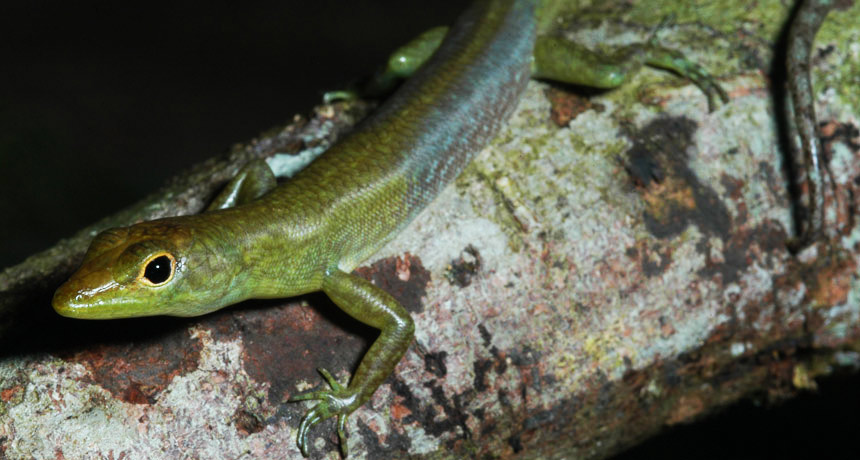Fighting like an animal doesn’t always mean a duel to the death

Pick an animal.
Choose wisely because in this fantasy you’ll transform into the creature and duel against one of your own. If you care about survival, go for the muscular, multispiked stag roaring at a rival. Never, ever pick the wingless male fig wasp. Way too dangerous.
This advice sounds exactly wrong. But that’s because many stereotypes of animal conflict get the real biology backward. All-out fighting to the death is the rule only for certain specialized creatures. Whether a species is bigger than a breadbox has little to do with lethal ferocity.
Many creatures that routinely kill their own kind would be terrifying, if they were larger than a jelly bean. Certain male fig wasps unable to leave the fruit they hatch in have become textbook examples, says Mark Briffa, who studies animal combat. Stranded for life in one fig, these males grow “big mouthparts like a pair of scissors,” he says, and “decapitate as many other males as they possibly can.” The last he-wasp crawling has no competition to mate with all the females in his own private fruit palace.
In contrast, big mammals that inspire sports-team mascots mostly use antlers, horns and other outsize male weaponry for posing, feinting and strength testing. Duels to the death are rare.
“In the vast majority of cases, what we think of as fights are solved without any injuries at all,” says Briffa, of Plymouth University in England.
Evolution has produced a full rainbow of conflict styles, from the routine killers to animals that never touch an adversary. Working out how various species in that spectrum assess when it’s worth their while to go head-to-head has become a challenging research puzzle.“In the vast majority of cases, what we think of as fights are solved without any injuries at all,” says Briffa, of Plymouth University in England.
To untangle the rules of engagement, researchers are turning to animals that live large in small bodies but don’t have sports teams named after them. At least not yet.
Deadliest matches
It’s hard to imagine nematodes fighting at all. There’s little, if any, weaponry visible on the see-through, micronoodle body of the species called Steinernema longicaudum. Yet in Christine Griffin’s lab at Maynooth University in Ireland, a graduate student offered a rare hermaphrodite to a male as a possible mate. Instead of mating, the male went in for the kill.
“We thought, well, poor hermaphrodite, she’s not used to mating, so maybe it’s just some kind of accident,” says Griffin, whose lab specializes in nematodes as pest control for insects. When the grad student, Kathryn O’Callaghan, offered females of another species, males killed some of those females too. When given a chance, males also readily killed each other. That’s how nematodes, in 2014, joined the list of kill-your-own-kind animals, Griffin says.
Killing another nematode is an accomplishment for a skinny thread of an animal with just two thin, protruding prongs. The male S. longicaudum slays by repurposing his mating moves.
When he encounters a female of his own species, the male coils his tail around her and positions the prongs, known as spicules, to hold open the entrance to her reproductive tract. To kill, a male just coils his tail around another male, or a female of a different species, and squeezes extra hard. Pressure ruptures internal organs; sometimes spicules even punch a hole during the fatal embrace. The grip lasts from a few seconds to several minutes. Of those worms paralyzed by the attack, most are dead the next day.
Other nematodes live in labs around the world without murdering each other. So why does S. longicaudum, for one, lean toward extreme violence? Its lifestyle of colonizing the innards of an insect inclines it to kill, Griffin suggests. An insect larva is a prize one male worm can monopolize, not to mention the only place he can have sex.
These nematodes lurk in soil without reproducing or even feeding until they find a promising target, such as the pale fat larva of a black vine weevil. Nematodes wriggle in through any opening: the larva’s mouth, breathing pores, anus. If a male kills all rivals inside his new home, he becomes the nematode Adam for generations of offspring perhaps totaling in the hundreds of thousands, Griffin says.
Territorial female slayers
A defendable bonanza like a weevil larva, or a fig, has become a theme in the evolution of lethal fighting. Biologists have studied violence in certain male fig wasps for decades, but more recent research has revealed that some females kill each other too.
When a female Pegoscapus wasp, a bit longer than a poppy seed, chooses one particular pea-sized sac of flowers, a fig-to-be, she’s deciding her destiny. That sac is most likely her only chance at laying eggs, and will probably be the fruit she will die in, says evolutionary ecologist Charlotte Jandér of Harvard University.
Shortleaf fig trees (Ficus citrifolia) have “a delicate flowery smell,” Jandér says, but the blooms are hidden inside the little green-skinned sacs. To reach these inner riches and lay one egg per flower in as many flowers as she can, the wasp must push through a tight tunnel. The squeeze can take roughly half an hour and rip her wings and antennae. Reaching the inner cavity carpeted in whitish flowers, “there is plenty of space for one wasp to move around,” Jandér says. But more than one gets cramped, and conflicts get desperate.
In a Panamanian wasp species that Jandér has watched, females “can lock on to each other’s jaws for hours and push back and forth,” she says. In a Brazilian species, 31 females were found decapitated among 84 wasps, reported Jandér, Rodrigo A.S. Pereira of the University of São Paulo and colleagues in 2015. That was the first documented female-to-female killing in fig wasps.
Walk away
From bellowing red deer stags to confrontational male stalk-eyed flies, many animal species have ways to back off rather than fight to the death. Searching for dynamics of less-than-deadly discord, Briffa studies sea anemones. And yes, anemones fight.
Beadlet sea anemones (
Actinia equina
) release sperm and eggs into open seawater, so the animals don’t need to argue over mates. For a prime bit of tide pool rock, however, tensions rise.
Below a beadlet’s pinkish, swaying food-catcher tentacles are what often look like “little blue beads,” Briffa says. These are fighting tentacles, or acrorhagi. When combat looms, the anemone inflates them. “Imagine someone pulling out their bottom lip to make a funny face,” he says.
It’s no joke for an impertinent neighbor. Anemones, distant relatives of stinging jellies, carry harpoon-shooting, toxin-injecting capsules in the acrorhagi. Combatants rake stinger acrorhagi down each other’s soft flesh. “It almost looks like they’re punching each other,” Briffa says. “When one of the anemones decides it’s had enough and wants to quit the contest, it actually actively walks away.”
“Walk” is used loosely here, says Sarah Lane, a postdoc in Briffa’s lab, as she alternately arches her hand and flattens it in a measured trip across the Skype screen. “Like a cartoon caterpillar?” she says, trying to describe the gait. “A concertina?”
When placed side by side in the lab for fighting tests, anemones concertina away or otherwise resolve the tension without any acrorhagi swipes about a third of the time. De-escalating makes sense considering that a full exchange “looks quite vicious,” Lane says. Strikes leave behind bluish fragments of acrorhagi full of stinging capsules, which kill tissue on the recipient. The attacker isn’t unscathed either; close-ups show open wounds where acrorhagi tissue was pulled out. An anemone “literally can’t hurt an opponent without ripping parts of itself off,” she says.
Injuries to an attacker from swiping, biting or other acts of aggression get overlooked in theorizing over how animals weigh the costs and benefits of dueling, Lane and Briffa argued in the April 2017 Animal Behaviour. The sea anemones may be an extreme example of self-harm from a strike, but they’re not the only one.
Humans can hurt themselves when they attack, and decision making around fighting has had some unintended consequences, Lane points out. In a bare-handed punch at somebody’s head, little bones in the hand crack — called boxer’s fractures — before the skull does. With the introduction of gloves around 1897, boxer’s fractures basically disappeared from match records, Lane says. Before gloves, however, records show no reported deaths in professional matches. Once gloves lessened the costs of delivering high-impact punches, deaths began appearing in the records.
Worth the fight?
Sea anemones don’t have a brain or centralized nervous system, yet costs and benefits of fighting somehow still matter. The animals clearly pick their fights, escalating some blobby sting matches and creeping away from others.
Just how anemones choose, or how any animal chooses when to fight and when to back down, turns out to be a rich vein for research. Theorists have proposed versions of two basic approaches. One, called mutual assessment, “is sussing out when you’re weaker and giving up as soon as you know — that’s the smart way,” Briffa says. Yet the evidence Briffa has so far, he says with perhaps a touch of wistfulness, suggests anemones use “the dumb way of giving up.”
Animals resort to this “dumb” option, called self-assessment, when they can’t compare their opponent’s odds of winning with their own. Maybe they fight in shadowy, murky places. Maybe they don’t have the neural capacity for that kind of comparison. For whatever reason, they’re stuck with “keep going until you can’t keep going anymore,” he says. Never mind if the fight is hopeless from the beginning.
The odds of fighting “smart” look better for the animals that Patrick Green of Duke University studies. Those creatures have a brainlike ganglion and come close to fighting with superpowers. He’s working with, of course, mantis shrimp.
The high-powered smashers among these small crustaceans flick out a club that can accelerate as fast as a bullet shooting out of a .22 caliber pistol. When the clubs wham a tasty snail, the bounce back creates a low-pressure zone that vaporizes water. “I always feel weird saying this because it seems just goofy, but that does release heat equivalent to the surface of the sun,” Green says. But only for a fraction of a microsecond.
When smasher mantis shrimp — male or female — fight each other, they don’t supernova rivals into oblivion. The reality, arguably stranger, is that they superpunch each other. But the blows land on an area that can withstand the force: the telson, a bumpy shield covering the rump (SN: 7/11/15, p. 13).
In Caribbean rock mantis shrimp (Neogonodactylus bredini), the battle is often over after just one to five blows too fast for the human eye to see. With combatants of equal size, the winner is not the animal that lands the most forceful blow, but the one that gets in the most punches. Then, with no visible gore, one dueler just gives up.
Now Green and Sheila Patek, also of Duke, propose that telson sparring, as they call it,
permits genuine mutual assessment, the smart way of losing a fight
. It’s difficult to figure out what lurks in the neural circuits of an arthropod, but the researchers presented multiple lines of evidence in the Jan. 31
Proceedings of the Royal Society B.
One strong clue came from matches Green staged between mantis shrimp of different sizes. He didn’t see a trend of smaller ones pointlessly pounding telsons as the lightweights fought bigger animals. Those bigger animals were going to win anyway, and it seemed as if the smaller ones got it, suggesting something more than self-assessment is going on, Green and Patek propose.
Researchers think they have seen mutual assessment in other animals too, among wrestling male New Zealand giraffe weevils (SN: 10/4/14, p. 4) and male jumping spiders that flip up banded legs in “Goal!” position to intimidate rivals. Analyzing assessment gets tricky. Game theorists have weighed in, but there’s debate over what kind of biological evidence truly distinguishes one form of assessment from another. And research in new directions is bringing more biological realism to the discussion of conflicts. Human scientists, dazzled by the sights and sounds that our own sensory world emphasizes, may be underestimating chemical cues. Among crawfish, “part of their fight is squirting urine in one another’s faces,” Briffa says.
Paradoxically peaceful
Many of the scariest-looking weapons end up causing little bodily harm. Some are specialized for combat that’s more strategic than gory. Other weapons look so scary they hardly ever get used.
Among the tools for odd but not life-threatening combat are the horns of the male Asian rhinoceros beetles studied by Erin McCullough, now at the University of Western Australia in Perth. Male Trypoxylus dichotomus compete furiously with each other and grow forked horns on their heads that stretch nearly two-thirds the beetle’s body length. The horns are surprisingly lightweight, but look cumbersome. “Like a Styrofoam leg sticking out of your forehead,” she says.
She watched the beetles in action on a muggy summer night lurking around ash trees at a university in Taiwan. Hardly blending in with the students, she decked out in leather gloves and a head lamp, making sure her shirts had the collars pulled way up. “You shouldn’t wear mosquito repellant when you’re working with insects,” she says.
The scene was “really messy and chaotic,” she recalls. Beetles flying out of the dark fought to dominate cracks in ash tree bark that oozed sap and attracted females. A dominant beetle would grip the bark and use his horn to flick incoming challengers off the branch left and right — until he was usurped. Getting thrown off the limb doesn’t kill losers; often they buzz right back for another try.
Yet evolutionarily speaking, a male prevented from mating might as well be dead, so the tactic was consequential. Males with longer horns are better at flicking off other males, but longer horns are more likely to snap, McCullough concluded. A broken horn doesn’t grow back, so the extravagant tool needs to be a pry bar of the right length, lightness and strength. Pristine horns on male beetles just starting their fighting careers have about four times the strength the horns need to resist cracking, about the safety factor that engineers build into bridges but less than the standard for elevator cables, she says.
Horns or antlers on male mammals often can kill, yet fatal fights may be rare. One of his favorite studies from decades-old literature, says Douglas Emlen of the University of Montana in Missoula, looked at about 1,308 sparring matches between male caribou in Alaska. With all this glaring, snorting and rushing, only six matches escalated into violent, bloody fights.
The caribou fit one of the paradoxical phases of the evolution of animal weaponry that Emlen studies. Usually evolution doesn’t favor extremes in teeth, horns or other such fighting body parts. Certain forms of sexual rivalry, however, can escape such stabilizing forces and expand extravagantly in a body-part arms race. There are common patterns to such arms races, he says, including some cheating.
Among the conditions that favor an arms race are rivalries playing out in one-on-one duels, he says. Imagine a magnificently endowed dung beetle in a tunnel, a female in the depths behind him, as he fends off rivals one by one for her attention. Growing bigger and bigger horns for an arms race becomes biologically expensive. Eventually, only an animal with the best nutrition, genes and luck can spare the resources to grow a truly commanding horn. At that point, horn size honestly signals a male that can overpower just about all rivals. Only if he confronts another supermale will he need to fight all out. The rest of the time, the signal value of his prodigious weaponry keeps the peace with barely a bump or a bruise.
Yet this is “a very unstable situation,” Emlen says. “It creates incentives for males to cheat.” Or maybe the word is “innovate.” He found that big-horned male dung beetles defending their tunnels could be outmaneuvered by small rivals who dug bypass tunnels around the guard zone and mated with the supposedly defended female. Beetle horns may not be the best analogy for human nuclear arsenals, but, Emlen notes, the innovations of cyberattacks have certainly bypassed hugely expensive national defense systems.
At the far extreme of animal rivalries are some species that blur the meaning of fights. Some butterflies, such as the speckled wood butterfly, “fight” without physical contact. Males compete for a little sunlit dapple on the forest floor by flying furious circles around each other until one gives up and scrams. No gore, but probably really exhausting.








